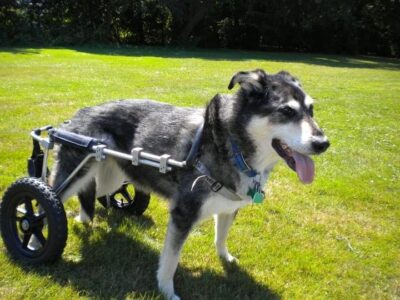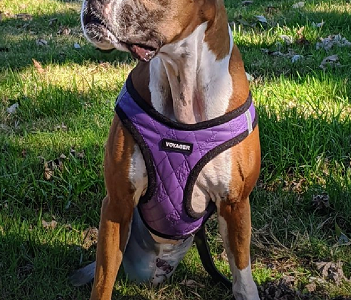
Spinal cord tumors in dogs aren’t an everyday occurrence, but they’re more common than you think. That’s what I learned from my vet when she shared how her dog had an inoperable tumor. She told me this information because she wanted to test my dog.
Sophie’s hind legs were slowly becoming weak and wobbly. Our veterinarian thought it might be due a tumor growing in her spine.
She started Sophie on a “prednisone trial” to see if her legs got stronger while she was taking the medicine. Prednisone is a steroid that reduces inflammation. Because tumors increase inflammation, we hoped to see an improvement in how Sophie walked.
Unfortunately, the prednisone had no effect and after a couple of weeks, we stopped using it.
Still, I remember hearing the word “tumor” and trying to prepare myself for the worst. That’s why I think it’s important for every pet owner to know the facts about spinal cord tumors. It’s better to be prepared for a potential health problem than to have it take you by surprise.

Ask & Discover
Get personalized content recommendations and answers drawn from our website. Simply type your question or topic of interest, and our AI assistant will help you find relevant articles, tips, and insights. You can also have a natural conversation to explore topics in more depth.
Overview of spinal cord tumors in dogs
Tumors are classified as Primary and Secondary. Primary growths start in the spine while secondary tumors start in another part of the body and spread to the spine.
Typically, they grow slowly and without any pain or symptoms until the tumor’s gotten big enough to cause damage. Tumors can be cancerous and noncancerous, but both cause harm to the spine.
There are four types of spinal tumors. The two most common are:
- Extradural tumors – These are tumors that grow outside the spinal cord and cause pressure and pain. They account for 50% of all tumors in the spine.
- Intradural-extramedullary tumors – These are tumors that grow inside the spinal cord, around the nerves. They make up 30% of spinal tumors.
The two less common tumors are: Intramedullary – Tumors that grows in the cells of the central nervous system. They account for 15% of tumors in the spine.
3. Intramedullary – Tumors that grow in the cells of the central nervous system. They account for 15% of tumors in the spine.
4. Peripheral nerve tumors – This is the rarest form that develops in the nerve roots of the spine. They account for only 5% of all spinal tumors.
Dog prone to spinal cord tumors
The typical patient is a medium to large breed dog who is middle-aged, at about 6-years-old.
Common symptoms

Symptoms depend on the location of the tumor. Here are the overall signs owners need to know:
- Changes in the gait like limping or an unsteady walk.
- Neurologic symptoms – This can be urinary and fecal incontinence or sudden paralysis.
- Weakness in the back or front limbs.
- Pain – Dogs show signs of a sharp pain that’s limited to one area of the neck or back. Some dogs are reluctant to lift their heads while others hunch their backs.
- Loss of balance or coordination.
How veterinarians make a diagnosis
Veterinarians start the diagnosis process with a Myelogram. This is an imaging tool similar to an x-ray that injects dye into the spine to see where a tumor is located. If a tumor is found, a CT scan or MRI is ordered to give your vet further information about the size of the tumor and whether it can be reached by surgery.
It’s important to know the exact location of the tumor, the shape, how it is growing and the amount of damage it’s doing to your dog’s spine.
Bloodwork, urinalysis and a biopsy may also be ordered. The first two tests tell your vet about any infections or inflammation your dog is fighting. The biopsy takes a small piece of the tumor or surrounding tissue to better understand the makeup of the tumor.
Treatment options

There are treatment options available for your pet. The best course of treatment should be determined by the tumor location, type, and grade with a goal of minimizing the symptoms of the tumor as quickly as possible.
PetCure Oncology
Surgery is the treatment most often prescribed for dogs with extradural and intradural-extramedullary spinal tumors. These primary growths have a better outcome than tumors that are due to cancer in another part of the body.
But, in every case the process has many risks. A vet must decide if the tumor can be fully removed without injuring the spinal cord.
Veterinarians consider these other factors to determine the right course to take:
The number of tumors.
The difficulty in reaching them with surgery.
A dog’s overall health.

Get the Essential Guide
The Essential Guide of Products for Handicapped Dogs e-book is a labor of love for me. I wrote it to answer your most pressing questions about where to find the best products for your wheelchair dog. You’ll find products you didn’t know existed and each will improve your dog’s quality of life. Print a copy and keep it by your side.
Tumors due to cancer
Dogs with cancerous tumors in their spine are being offered new therapies that include chemotherapy, radiation and surgery. Many dogs receive a combination of surgery and radiation therapy and it’s extending their lives.
Studies show that when these two treatments are administered, the results can extend a dog’s life an additional 11 – 23 months.
CyberKnife technology
A brand-new cutting-edge therapy for dogs with spinal tumors is also adding years to a dog’s life. The treatment is called a CyberKnife surgery. It uses targeted Stereotactic Radiation (SRS) that’s directed at a cancerous growth. The advanced therapy is non-invasive and minimizes damage to healthy tissue. It’s particularly beneficial in shrinking tumors that are in hard-to-reach areas.
During the treatment a dog is placed under anesthesia while a team of veterinarians direct a robotic arm to deliver precisely targeted doses of radiation to different angles of a tumor.
CyberKnife therapy benefits dogs because less radiation treatments are needed and there are fewer side effects.
Prognosis for spinal cord tumors in dogs
As with any tumor, the outcome depends a lot on how soon treatment is started. That said, the overall prognosis for spinal cord tumors in dogs is poor. The majority of patients have a survival rate of less than 6 months.
As a pet parent, it’s important to consider your dog’s well-being and comfort at this time. Work with your veterinarian to find ways to reduce any pain your dog’s experiencing and talk about techniques for taking care of your pet at home.
Palliative care is often prescribed to help pet families find ways to maintain their dog’s quality of life. These professionals can offer advice about ways to reduce pain and keep a dog comfortable.
Others pet parents turn to canine herbal supplements that boost the immune system. Talk with your vet about a trusted brand.
Want more information? Click on the stories below.
7 Of The Most Common Spinal Cord Diseases in Dogs
Degenerative Myelopathy in Dogs: What Pet Owners Should Know






Hi, My 12 English Lab recently was very healthy till last wednesday. By thursday morning my pup couldn’t get up and hold his weight. We were horrified by this. We rushed him to a ER and then to a hospital. There they did an Mri and found 3 masses. One was behind his right eye. Which caused him blindness in his eye. The other was in the spine of his neck causing him to be unable to walk. The last one was in his forehead. The outcome was not what we expected. The Drs decided to try steroids to see if this would help with the inflammation. With the hope of him walking again. They helped his eye but as for the spine it did not. He breathing unfortunately became very labored and not normal. Assuming, Cause all i can do is assume is the mass in hi spine progressed more and was cutting off his airway. We asked all the questions on if he would live through the night. The reality was my dog was dying. I guess the question i will always have is why he went so fast. Why he didn’t show any pain. Because this did not happen overnight. The tumors i mean. We did what we think was the right decision and held him as he went to sleep. I wish we would have found these earlier. Thanks for listening.
Paul
Paul, Please accept my condolences for your loss. It sounds like you might the right decision for your Lab. Unfortunately the prognosis for spinal cord tumors isn’t very good. My guess is that the location of the masses didn’t cause your dog much pain until the very end. Take care, Sharon
Sorry for your loss Paul. We had a similar scenario. Around Halloween this year, our 100lb GSD started limping on a hind leg, got better in a few days, passed a lameness exam, no issues. But Tues before Thanksgiving, started limping again, by wed night, was knuckle dragging that leg, and very wobbly. So off to the ER on turkey day, left her overnight to find a doctor that could do an MRI asap. Overnight ER found she lost all rear motor function by the MRI on Fri.
Doctor found a spine sarcoma working its way inside out: bone cancer. He was surprised his X-rays showed *nothing*–that the bone “shell” was blocking the sarcoma/tumor. Luckily, the MRI showed everything: he said [spine] sarcomas are living tissue and from that they require blood flow/O2 to survive, and thus as they grow, they require even more blood flow, which makes them grow even faster (i.e. cancerous). New veins get created, etc… to feed the sarcoma. It’s a vicious cycle. For my girl, the sarcoma was pinching the spinal cord as it was growing and pushing it upward (thus paralysis), and growing rapidly downward consuming the bone. You could see it in the MRI’s sagittal view. From our routine mile walk on a Monday to full rear paralysis by Friday. And my girl showed no signs of pain, mainly frustration why she losing control (walk, pee, poop, etc…). Doctor said she still had sensitivity (skin feeling, awareness, etc..), just no motor function–confirmed with scratching her hind tail would wiggle. And he said sarcomas can grow very fast, like a pimple, given sufficient blood flow. Hopefully that can provide you with some insight on why it happens so quickly and why it can be hard to detect.
Unfortunately, some sarcoma grow in the wrong places and only [expensive] MRI or biopsy can provide data–just sucks. Our wellness plan check ups showed no signs of this, though one time vet thought she had a lump of possible lung cancer in an xray 2yrs ago. For us, theoretical option was to remove the bone (having a spine w/o a bone possible?), which the doctor said didn’t make sense with a good chance other cancers will appears in the area and her being 11yrs old. We put her down 3 weeks ago at home. I’m still in shambles, disbelief, life upside-down. As my 1st dog, I picked her up as owner #3 from the city shelter at age 2, and she lived 9 colorful, happy years with me going everywhere I went.
I’m sorry about the loss of your dog. It sounds like you did everything possible for her.
I have a mini Schnauzer that apparently has a tumor putting pressure on spinal nerves. We haven’t gotten an MRI to confirm, but symptoms seem to indicate that. She started showing symptoms and lost control of her back legs for a time. She doesn’t seem to be in pain, more like frustration; she could not hold her stance to urinate or poo. Prednisone has helped a lot in this case. It was mid May that she started having problems, went for about 2 weeks where she was really unable to walk and was beginning to lose control of her output. 10mg Prednisone every day along with starting her on Dasoquin joint supplements got her back on her feet and back to 90% of her old strength. After 1 month of 10mg daily, we went to 10mg every other day, and then stopped. That lasted about a week before she suddenly was losing control again, so back to 10mg every other day and again… so far… she’s doing very well again. Now I just wonder how long it will work and worry about what possible effect from the drug might happen.
I’m sorry you and your dog are going through this ordeal. Unfortunately, the prognosis for spinal cord tumors isn’t very optimistic, but I’m glad the Prednisone is easing her pain. You might want to talk with your vet about the side effects, but my guess is the benefits of the medication outweigh the risks. Have you talked with the vet about laser knife therapy? It’s a new non-invasive procedure for both human and canine tumors that are inoperable or hard to reach. You might also want to look at a support harness to help steady her when she urinates. I hope your girl is with you for a long time. Best, Sharon